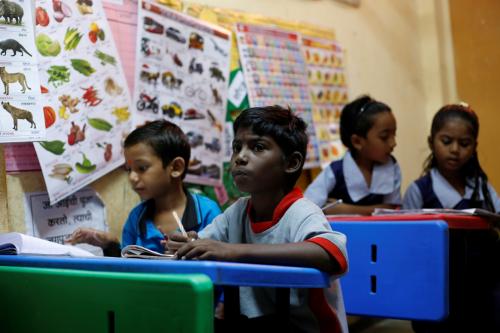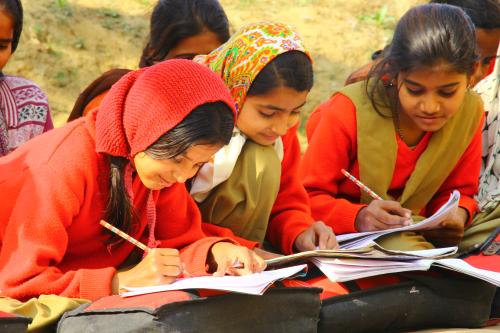This blog is a summary of the new report, “Development of student and teacher measures of Happiness Curriculum factors.”
“Knowing if you are happy from within or not is very important because, when your actions are driven from this state of happiness nothing seems to be a burden.” Manish Sisodia, deputy chief minister and minister of education, Delhi government.
Happiness means different things to different people. In a place where the majority of students in public education systems (government schools) are first generation learners, Delhi’s Happiness Curriculum is designed to strengthen the foundations of happiness and well-being for all students and change the relationship of the student with her teacher and school through a 35-minute class delivered every day for every student in kindergarten to grade eight across 1,030 schools in Delhi. Started in July 2018, the Happiness Curriculum is the first attempt of its kind to reimagine the classroom and the school for over 800,000 students.
In this strange time of discontinuities and uncertainties, education is more important than ever as we struggle to engage constructively with the world and its inhabitants. Our education systems—and our societies more broadly—must look beyond knowledge and facts, and address how to manage the experience of life.
Life is complex and often difficult to understand, and we need the self-awareness, confidence, and social-emotional skills to navigate it. We need young people who are emotionally stable, focused, and who contribute. The Delhi government has recognized these needs and wants to ensure that their students receive not only literacy and numeracy skills, but also the emotional and cognitive skills required to function successfully in society. Delhi’s “Happiness Curriculum” has been designed to facilitate the development of these such skills.
Over the past year, Brookings researchers have spent time in Delhi classrooms in order to understand what a Happiness Curriculum and its components look like in practice, and to talk with young students and teachers about their experiences of changing classroom practices. Partnering with Dream a Dream, Brookings has published a report which provides:
- a summary of the factors believed to contribute to happiness, as reflected in the Happiness Curriculum
- information about the development of a survey approach to measure these happiness factors
- a description of the issues confronting educators as they evaluate the program.
Interviews with students and teachers from happiness class
The research team attended happiness classes to better observe and understand both the ideology and activities of the Happiness Curriculum. These observations were followed by group interviews across several schools in Delhi. Students noted positive change in the quality of relationships with their teacher, increased participation in classes, and the ability to focus and feel calm. Teachers talked about the increased willingness of students to speak up in class, changes in prioritizing values over academic success, and the freedom granted by the curriculum to vary their pedagogical styles.
The survey
The study upon which this report is based was designed to complete some initial steps in evaluating the program. The first step was an analysis of the curriculum and its cohesiveness with the objectives of the Happiness Curriculum. The next step was to develop tools to provide information concerning student and teacher behaviors associated with the Happiness Curriculum. The two surveys developed—one for students and one for teachers—reflect the competencies aligned with the Happiness Curriculum objectives and learning outcomes. For anticipated use in future evaluation studies, the two surveys will provide a basis for capturing student and teacher functioning on these competencies.
Development of the survey approach drew on a literature review, analysis of the Happiness Curriculum content and objectives, group interviews with students and teachers, and student and teacher responses to piloted survey items. The study locates the philosophical underpinnings of the Happiness Curriculum within the positive psychology and social-emotional literature, and how these underpinnings are translated into the realities of a daily classroom routine was our focus.
Conclusion
The intended Happiness Curriculum learning outcomes mainly target mindfulness, critical thinking, and reflection, and a cluster of social-emotional skills. High-level findings showed that self-awareness, awareness of others, and communication were increasingly evidenced from lower to higher grades. Mindfulness is strong across all grades, while critical thinking varies across grades but is strongest in grade six. Management of stress is not represented strongly across any grades. The results demonstrate that the Happiness Curriculum writers were responsive to the maturation of students, both socially and cognitively.
But how do we know if initiatives such as the Happiness Curriculum really achieve their goals? As children grow, it will take time to confirm the long-term impact of the program. Nurturing a child’s ability to focus takes time—as distinct from teaching a child a fact—and enhancing a child’s ability to see the perspective of another takes empathy—as distinct from teaching a child to recite times tables. In the matter of happiness elements, correct versus incorrect answers are meaningless, but this study takes a first step into how we go about evaluating program outcomes in this space.
The Happiness Curriculum has already shown positive improvements in relationships both in and outside of classrooms in Delhi schools. Students are more reflective about small arguments with their peers, and more insightful in understanding home dynamics. We are excited to see what other changes will take place in the long term and how it may inform policies nationally and internationally. At its heart, the Happiness Curriculum is designed to ensure that the well-being of students and their teachers is front and center in learning and thriving. This was beautifully captured by one young student: “I have learned to notice my mother’s emotions of happiness, sadness, and anger, and when she looks sad, I have learned to support her, hug her, and be there for her.”
The Brookings Institution is committed to quality, independence, and impact.
We are supported by a diverse array of funders. In line with our values and policies, each Brookings publication represents the sole views of its author(s).









Commentary
The happy classroom: Insights from our study of schools in Delhi, India
August 14, 2020